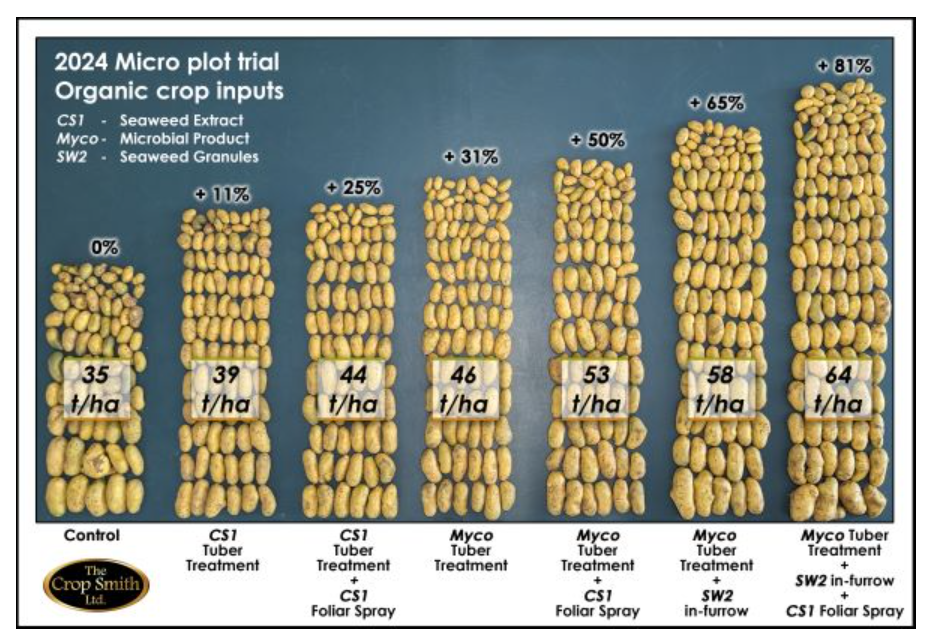
Exhibition time: 17-19 March, 2026 Shanghai, China
 中文
中文

Exhibition time: 17-19 March, 2026 Shanghai, China
 中文
中文

In the ever-evolving world of agriculture, farmers are continually seeking ways to enhance crop yields, improve plant health, and maximize the quality of their produce. One of the most promising strategies in recent years has been the use of biostimulants—natural products that enhance plant growth and resilience. But there’s an emerging trend that takes this concept even further: stacking biostimulant products. By combining different types of biostimulants, farmers can achieve results which surpass those that any single product could offer on its own. A recent micro-trial, carried out on potatoes by Agrology Ltd, highlights just how powerful this approach can be.
The Micro-Trial: A Closer Look
The trial involved several treatments applied to potato crops, using a variety of biostimulant products both individually and in combination. The products tested included seaweed granules mixed into the soil, seaweed extract used as a tuber treatment, microbial in-furrow sprays, and seaweed foliar sprays. Each treatment was carefully applied to different sets of potato plants, and the results were measured to assess the impact on crop yield and quality.
What became clear from the trial is that the stacking of these biostimulants—using them in various combinations rather than in isolation—produced significantly better outcomes for the potatoes.
Why Stacking Works
Stacking biostimulants works by leveraging the complementary effects of different products, each targeting a unique aspect of plant health. Seaweed extracts, for instance, are rich in hormones and nutrients that stimulate root growth and improve stress tolerance. When used as a tuber treatment, they help the young potato plants establish more robust root systems early in their growth cycle.
Microbial products, on the other hand, enhance soil health by promoting beneficial microbial activity, which in turn improves nutrient availability and uptake. When applied in-furrow they ensure that the developing potato roots have immediate access to a thriving microbial community, enhancing their ability to absorb essential nutrients.
Seaweed granules, when mixed into the soil, slowly release their beneficial compounds, providing a steady supply of nutrients and growth-promoting substances throughout the growing season. This steady release ensures that the plants do not experience nutrient spikes, which can lead to imbalances and suboptimal growth.
Finally, seaweed foliar sprays offer a direct way to deliver essential nutrients and stress-relief compounds to the potato plants during critical growth stages. Regular foliar applications allows for rapid uptake, particularly during periods of high stress, such as hot and dry weather conditions or pest attacks.
The Results Speak for Themselves
The micro-trial revealed that while each of these treatments provided benefits when used individually, the most impressive results came from combining them. The stacking of seaweed granules with microbial in-furrow spray and seaweed foliar spray, for example, led to the highest yields and best overall plant health, showing an 81% increase. The potatoes from these treatments were larger, more uniform, and had fewer instances of disease compared to those treated with just one type of biostimulant.
This outcome underscores the value of a holistic approach to crop management. By using a combination of biostimulants, farmers can address multiple aspects of plant health simultaneously—improving root development, enhancing nutrient uptake, boosting stress resistance, and optimizing overall growth.
A Future-Forward Approach to Agriculture
As the agricultural industry continues to adapt to the challenges of climate change, soil degradation, and the need for sustainable practices, the stacking of biostimulant products represents a forward-thinking strategy. It not only helps in maximizing yields but also in producing healthier, more resilient crops with fewer chemical inputs. For potato farmers, in particular, the evidence from this micro-trial suggests that stacking biostimulants could be the key to unlocking the full potential of their crops.
Source:farmersreviewafrica.com